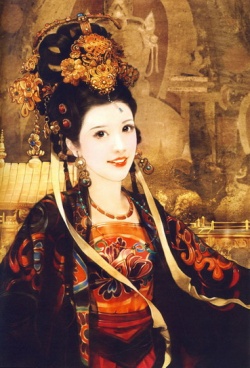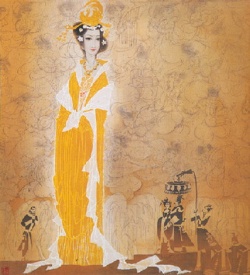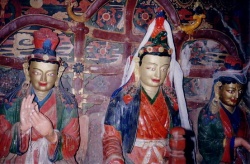Princess Wencheng
Princess Wencheng (Tibetan: Mung-chang Kungco, Chinese: 文成公主, pinyin: Wénchéng Gōngzhǔ) (died 680) was a niece of the powerful Emperor Taizong of China's Tang Dynasty, who left China in 640, according to records,
arriving the next year in Tibet to marry the thirty-seven-year-old Songtsän Gampo (605?–650 CE) the thirty-third king of the Yarlung Dynasty of Tibet, in a marriage of state as part of a peace treaty along with large quantities of gold. She is popularly known in Tibet as Gyasa, or 'Chinese wife'.
The princess is portrayed as a Buddhist and, along with Songtsän Gampo's Nepalese wife, Bhrikuti Devi, is said to have introduced Buddhism to Tibet. The details regarding Wencheng are scarce and there is uncertainty amongst historians as to whether she truly existed.
The Chinese records mention receiving an envoy in 634 from Songtsän Gampo wherein the king requested (Tibetan sources say demanded) to marry a Chinese princess and was refused.
In 635/636 the Tibetan king's forces attacked and defeated the 'A zha people (Chinese: Tüyühün), who lived around Lake Koko Nor in present-day Qinghai, along an important trade route into China.
After a campaign against China in 635–6 (OTA l. 607) (during which Chinese won) the Chinese emperor agreed (under threat of force, according to Tibetan histories) to marry a Chinese princess to king Songtsän Gampo as part of the diplomatic settlement.
As a marriage of state, the union must be considered a success as peace between China and Tibet prevailed for the remainder of Songtsãn Gampo's reign.
The legends say that she losts a mirror called Sun and Moon, on the actual Riyue Mountain that allowed her to see Xi'an, and that the Daotang river that flow near this moutain is born of her tears.
The wedding's cultural importance
Myths aboutSongtsän Gampo and his Chinese bride Wencheng that appeared during the Middle Ages transformed Songtsän Gampo into a cultural hero for Tibetans, based on his marriages.
Songtsän Gampo and Princess Wencheng married in hopes of promoting harmonious, matrimonial relationships between his royal family and those of his neighboring countries (China and Tibet), as well as to expand Tibet's boundaries and influence.
It is widely believed that his state marriages to Nepalese princess Bhrikuti and Chinese princess Wencheng (popularly known as Gyasa and worshiped as a goddess of mercy to the Tibetians) brought the sacred image of Sakyamuni and Buddhism in general to Tibet, and further, that their complicated relationship as co-wives led to the construction of the Jokang Temple, whereupon the city of Lhasa.
Because the stories of her matrimonial journey are evolving and ever increasing, it is difficult to identify fiction from historical reality.
These stories are included in such medieval romances as the Mani-bka'-'bum, and historiographies such as the Rgyal-rabs Gsal-ba'i Me-long.
In addition to the Chinese culture and Buddhist religion, Wencheng brought with her promises of trade agreements and safe passage on the Silk Road route and a substantial amount of dowry which contained not only gold,
but fine furniture, silks, porcelains, books, jewelry, musical instruments, and medical books.
Additionally and more importantly, Wencheng arrived with new agricultural methods.
This included the introduction of seeds of grains and rapeseed, other farming tools and advice on how to increase Tibetan agricultural productivity.
Wencheng was also credited for introducing Tibet with other skills in metallurgy, farming, weaving, construction,manufacture of paper and ink as well as developing the Tibetan alphabet and writing system.
Chinese sources credit Wencheng with bringing Chinese culture to Tibet, but this is not corroborated by Tibetan sources. Tibetans believe that it was Songtsän Gampo who promoted Tibet's technical and social progress by establishing his capital at Lhasa,
building the Tubo regime into a powerful kingdom, and whose main building strategy was purposely to seek ways to introduce new cultures into his Tibetan kingdom.
According to Chinese sources, Wencheng was reverenced for being one of the diplomat brides who brought much needed positive Han Chinese culture to the peoples beyond their borders - expanding their knowledge - in whom the imperial court often looked down upon as barbaric.
Changzhug monastery in Nêdong is also connected with Wencheng: a tangka embroidered by Wencheng is kept in one of its chapels.
Wencheng's legacy and influence still lives on. Generations of poets continue to write countless verses to praise her doings.
Two traditional days, the fifteenth day of the fourth month as well as the fifteenth day of the tenth month of each Tibetan year is celebrated with singing and dancing in her honor.
Historic Relics such as the statues of Songtsän Gampo with Princesses Wencheng are still worshiped and displayed for all to see along the trail of their wedding trip as well as in the Potala Palace at Lhasa to this day.


